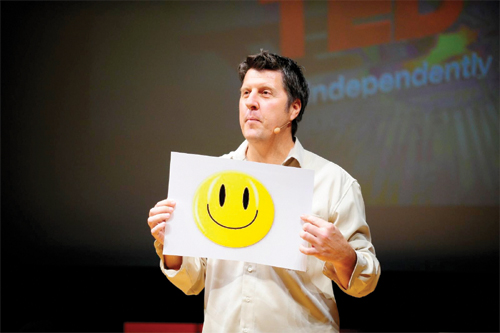Presentation Zen: Simple Ideas on Presentation Design and Delivery, 2nd Edition (Ira Katz's Library) (4 page)
Authors: Garr Reynolds

The six aptitudes are: design, story, symphony, empathy, play, and meaning. Mastering these aptitudes is not sufficient; leveraging these aptitudes has become necessary for professional success and personal fulfillment in today’s world. The introduction to the aptitudes that follows is written with multimedia-enhanced presentations in mind. But, you could take the six aptitudes and apply them to the art of game design, programming, product design, project management, health care, teaching, retail, and so on. The slide below summarizes six of the key points found in Pink’s book.

(The original images in the slide are from a vector file from iStockphoto.com, file no. 700018.)
To many business people, design is something you spread on the surface, like icing on a cake. It’s nice, but not mission critical. This is not design to me—it’s decoration. Decoration, for better or worse, is noticeable. It is sometimes enjoyable and sometimes irritating, and it is unmistakably there. The best designs, however, are so well done that the observer never even consciously notices the design. Think about the design of a book or the signage in an airport. We take note of the messages that the design helped make utterly clear, but not the color palette, typography, concept, etc.
Design starts at the beginning, not at the end—it’s not an afterthought.
If you use slideware in your presentation, the design of the visuals needs to begin in the preparation stage, before you even turn on your computer. During the preparation stage, you slow down and “stop your busy mind” so you can consider your topic, objectives, key messages, and audience. Only then will you begin to sketch out ideas that will appear in some digital visual form.
Facts, information, data. Most of it is available online or can be sent to people via e-mail, PDF, or hard copy through snail mail. Data and fact have never been more widely available. Cognitive scientist Mark Turner calls storytelling “narrative imagining,” something that is a key instrument of thought.
We are wired to tell and receive stories. We are all born storytellers (and “storylisteners”). As kids, we looked forward to show-and-tell, and we gathered with our friends at recess and lunchtime to tell stories about real things and real events that mattered, at least to us.
But somewhere along the line, “story” became synonymous with fiction or even falsehood. So story and storytelling have been marginalized in business and academia as something serious people do not engage in. But, from what college students tell me, I’ve concluded that the best and most effective professors are the ones who tell true stories. From my students’ point of view, the best professors don’t just go through the material in a book. They put their own personality, character, and experiences into the material in the form of a narrative, which is illuminating, engaging, and memorable. Stories can be used for good—for teaching, sharing, illuminating, and, of course, honest persuasion.
Focus, specialization, and analysis have been important in the Information Age, but in the Conceptual Age, the ability to synthesize seemingly unrelated pieces to form and articulate the big picture is crucial—even a differentiator. Pink calls this aptitude “symphony.”
The best presenters can illuminate relationships we may not have seen before. They can see the relationships between relationships. Symphony requires that we become better at seeing—truly seeing—in a new way. Anyone can deliver chunks of information and repeat findings that are represented visually by bullet points on screen. What we need are people who can recognize the patterns and are skilled at seeing the nuances and simplicity that may exist in a complex problem. Symphony in the world of presentation does not mean dumbing down information into the sound bites and talking points so popular in the mass media. Symphony is about applying our whole mind—logic, analysis, synthesis, intuition—to make sense of our world (that is, our topic), find the big picture, and determine what is important and what is not before the day of a talk. It’s also about deciding what matters and letting go of the rest.
Empathy is emotional. It’s about putting yourself in the position of others. It involves an understanding of the importance of others’ nonverbal cues and being aware of your own. Good designers, for example, have the ability to put themselves in the position of the user, customer, or audience member. This is a talent, perhaps, more than a skill that can be taught—but everyone can get better at it. Empathy allows a presenter, even without thinking about it, to notice when the audience is “getting it” and when they are not. The empathetic presenter can make adjustments based on his or her reading of a particular audience.
In the Conceptual Age, says Pink, work is not just about seriousness, but about play as well. While each presentation situation is different, in many public speaking situations playfulness and humor can go a long way toward making a presentation palatable. Humor, in this sense, does not imply joking or clown-like informality, but rather, good, old-fashioned humor that leads to laughter.
In Pink’s book, Indian physician Madan Kataria points out that many think serious people are the best suited for business—that serious people are more responsible: “[But] that’s not true. That’s yesterday’s news. Laughing people are more creative people. They are more productive people.”
Somewhere along the line, we were sold the idea that a real business presentation or academic talk must be dull and devoid of humor—something to be endured, not enjoyed. And if you use multimedia tools, the more complicated, detailed, and difficult to see, the better. This approach is still alive and well today, but we can hope in the future that this, too, will become “yesterday’s news.”

TEDxTokyo Curator Patrick Newell plays with the audience on stage between presentations.
(Photo: TEDxTokyo/Andy McGovern.)
Making a presentation is an opportunity to make a small difference in the world, whether it’s in your community, company, or school. A presentation that goes badly may have a devastating impact on your spirit (and on your career). But a presentation that goes well can be extremely fulfilling for both you and the audience, and it might even help your career. Some say that we “are born for meaning.” We live for self-expression and an opportunity to share what we believe is important. If you are lucky, you’re in a job that you feel passionate about. If so, then it’s with excitement that you look forward to the possibility of sharing your expertise—your story—with others. Few things can be more rewarding than connecting with someone by teaching something new or sharing something you believe is very important with others.
Audiences are so used to death-by-PowerPoint that they’ve seemingly learned to see it as normal, even if not ideal. However, if you are different—if you exceed expectations, show the audience that you’ve thought about them, done your homework, know your material, and demonstrated through your actions how much you appreciate being there—chances are you’ll make an impact and a difference, even if it’s just in the smallest of ways. There can be great meaning in even these small connections.
Design. Story. Symphony. Empathy. Play. Meaning. Dan Pink’s
A Whole New Mind
gives us the context of the new world we’re living in and explains why “high-touch” talents—which include exceptional presentation skills—are so important today. Professionals around the globe need to understand how and why the right-brain aptitudes of design, story, symphony, empathy, play, and meaning are more important than ever. The best presentations of our generation will be created by professionals—engineers as well as CEOs and creative types—who have strong “whole mind” aptitudes and talents. These are not the only aptitudes needed by the modern presenter, but mastering these talents along with other important abilities (such as strong analytical skills) will take you far as a communicator in the Conceptual Age.
Seth Godin
Speaker, blogger, and author of
We Are All Weird
www.sethgodin.com
Marketing guru and presenter extraordinaire Seth Godin says presentation is about the transfer of emotion.

It doesn’t matter whether you’re trying to champion at a church or a school or a Fortune 100 company, you’re probably going to use PowerPoint. PowerPoint was developed by engineers as a tool to help them communicate with the marketing department—and vice versa. It’s a remarkable tool because it allows very dense verbal communication. Yes, you could send a memo, but no one reads anymore. As our companies are getting faster and faster, we need a way to communicate ideas from one group to another. Enter PowerPoint.
PowerPoint could be the most powerful tool on your computer. But it’s not. Countless innovations fail because their champions use PowerPoint the way Microsoft wants them to, instead of the right way.
Communication is about getting others to adopt your point of view, to help them understand why you’re excited (or sad, or optimistic, or whatever else you are). If all you want to do is create a file of facts and figures, then cancel the meeting and send in a report.
Our brains have two sides. The right side is emotional, musical, and moody. The left side is focused on dexterity, facts, and hard data. When you show up to give a presentation, people want to use both parts of their brains. So they use the right side to judge the way you talk, the way you dress, and your body language. Often, people come to a conclusion about your presentation by the time you’re on the second slide. After that, it’s often too late for your bullet points to do you much good. You can wreck a communication process with lousy logic or unsupported facts, but you can’t complete it without emotion. Logic is not enough. Communication is the transfer of emotion.
Champions must sell—to internal audiences and to the outside world. If everyone in the room agreed with you, you wouldn’t need to do a presentation, would you? You could save a lot of time by printing out a one-page project report and delivering it to each person. No, the reason we do presentations is to make a point, to sell one or more ideas.
If you believe in your idea, sell it. Make your point as hard as you can and get what you came for. Your audience will thank you for it, because deep down, we all want to be sold.
How to Improve Immediately
First, make slides that reinforce your words, not repeat them. Create slides that demonstrate, with emotional proof, that what you’re saying is true, not just accurate. No more than six words on a slide. EVER. There is no presentation so complex that this rule needs to be broken.
Second, don’t use cheesy images. Use professional stock photo images. Talking about pollution in Houston? Instead of giving me four bullet points of EPA data, why not read me the stats but show me a photo of a bunch of dead birds, some smog, and even a diseased lung? This is cheating! It’s unfair! It works.
Third, no dissolves, spins, or other transitions. Keep it simple.
Fourth, create a written document. A leave-behind. Put in as many footnotes or details as you like. Then, when you start your presentation, tell the audience that you’re going to give them all the details of your presentation after it’s over, and they don’t have to write down everything you say. Remember, the presentation is to make an emotional sale. The document is the proof that helps the intellectuals in your audience accept the idea that you’ve sold them on emotionally. Don’t hand out printouts of your slides. They don’t work without you there.
The home run is easy to describe: You put up a slide. It triggers an emotional reaction in the audience. They sit up and want to know what you’re going to say that fits in with that image. Then, if you do it right, every time they think of what you said, they’ll see the image (and vice versa). Sure, this is different from the way everyone else does it. But everyone else is busy defending the status quo (which is easy) and you’re busy championing brave new innovations, which is difficult.

Sample Slides
Here are a few sample slides from one of Seth’s presentations. Without Seth, these visuals are almost meaningless. But with Seth’s engaging narrative, the visuals help illuminate a memorable story.
Lyza Danger Gardner
